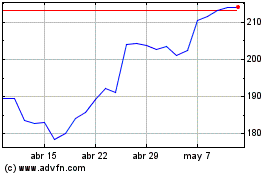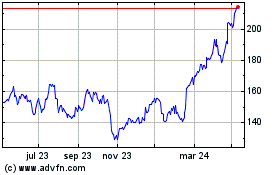A big investor, who is seeking a board seat, opposes Jes
Staley's global ambitions
By Margot Patrick
This article is being republished as part of our daily
reproduction of WSJ.com articles that also appeared in the U.S.
print edition of The Wall Street Journal (May 2, 2019).
Jes Staley runs one of the last full-service banks left in
Europe that compete with Wall Street. The way the 62-year-old
American banker sees it, his restructuring of U.K.-based Barclays
PLC has primed it to take on the likes of Goldman Sachs Group Inc.
and Morgan Stanley.
British-born investor Edward Bramson couldn't agree less, and
his New York firm has bought a sizable stake in Barclays. He is
trying to force the bank to scale back its Wall Street ambitions,
to become a consumer and commercial lender with smaller
investment-banking operations.
So far, Mr. Staley, the chief executive, is having none of it.
"He wants us to retreat into a foxhole? He should go back to
Connecticut," Mr. Staley has told colleagues, referring to the
state where Mr. Bramson has a home and raises horses.
The fight over the future of Barclays will help determine
whether any of Europe's banks can retain global ambitions.
For centuries, the U.K. was synonymous with international
banking, and London was the first stop for companies and
governments looking to raise money. Then its banks ventured
overseas to grab a greater share of lending and trading, bringing
some of them close to death during the financial crisis a decade
ago.
Today, U.S. banks dominate fundraising and trading, buoyed by
healthier balance sheets and robust American capital markets.
Mr. Staley has a vision for Barclays, which absorbed much of
Lehman Brothers after its collapse. He wants it to become a compact
version of JPMorgan Chase & Co. -- the bank where he spent more
than three decades of his career.
Making that happen hasn't been easy. The bank's share of global
investment-banking revenue has risen a couple of notches, but
returns on capital for the unit are below targets and the stock
price has declined. Mr. Staley recently forced out the head of the
investment bank and took the reins himself.
Mr. Staley said last week the bank has no intention of changing
course. "We like the progress we're making in the corporate and
investment bank....And we're going to continue with the strategy we
set out three years ago."
By refusing to retreat, Mr. Staley is going against the grain in
Europe. Stock valuations rose at UBS Group AG and Credit Suisse
Group AG after they decided to narrow their focus several years
ago.
Mr. Bramson's investment firm, Sherborne Investors, in a letter
to Barclay's shareholders in early April, pressed its case for a
strategic reversal. It argued that in the post-financial-crisis
world only the biggest American banks are in a position to offer
the full suite of investment-banking products.
"We believe that the current strategy is untenable in the long
run," the letter said.
Mr. Bramson, 68, has demanded a seat on Barclays's board of
directors. Shareholders are scheduled to vote on that resolution on
Thursday. While few Barclays shareholders have said they would vote
for him, many have expressed frustration with the share price.
Mr. Bramson has succeeded before in getting his nominees elected
to boards that have dismissed his calls for change. In its recent
letter to Barclays shareholders, Sherborne said Mr. Bramson has
"significant insight" to contribute and could be a stabilizing
influence on the bank.
In its own letter to shareholders in April, the Barclays board
said it strongly opposes him joining, calling his style "disruptive
and uncollaborative."
There have been three meetings between Messrs. Staley and
Bramson and their respective teams. All have been cordial, but none
have led to any action. "We come, we give the briefing and we get
no feedback," said one person in the Barclays camp.
In a meeting last spring, Barclays board member Crawford Gillies
told Mr. Bramson that the bank's first-half earnings would be
strong enough to quell any strategy doubts, according to a person
familiar with the discussion. The market won't care, Mr. Bramson
replied.
Barclays beat analysts' estimates for that period, but its
shares continued to slide, as Mr. Bramson had predicted.
Barclays says other factors are weighing on its share price,
such as Britain's planned departure from the European Union and
persistently low interest rates that hamper returns across the
banking industry.
Last September, Mr. Bramson wrote to the Barclays board asking
for a seat. A meeting with Mr. Bramson in November left Mr. Staley
frustrated that Mr. Bramson was creating uncertainty around the
Barclays stock but had said little about how he wanted to change
Barclays, according to one person familiar with the discussion.
What should we be doing differently? Mr. Staley asked at one
point, holding up his hands, according to the person familiar with
the discussion. Mr. Bramson didn't reply. Shortly after the
meeting, the chairman told Mr. Bramson he wasn't wanted on the
board.
The struggle over the soul of Barclays has been going on since
U.K. financial markets deregulated in the 1980s, fueling the
ambitions of British banks to be global players in securities
trading and corporate advice. A succession of CEOs pulled Barclays
back and forth between expansion in that area and retreat.
Former CEO Bob Diamond, also an American, supplied Barclays with
a key to competing with Wall Street on its home turf by buying
parts of Lehman Brothers during the financial crisis. Mr. Staley
was a top pick to succeed him, but the job went instead to a
Barclays retail banker who took an ax to the investment bank over
three years and saw the share price rise 50%.
Mr. Staley got a second shot at the top job in December 2015.
Informed by his long career at JPMorgan, he saw a chance for
Barclays to emulate the American giant with a balance of consumer,
commercial and investment banking -- a range of services that spans
credit cards in Germany and private banking in India.
Mr. Staley had left JPMorgan after concluding he wouldn't
succeed CEO James Dimon. He hired around 30 senior staffers from
JPMorgan, prompting Mr. Dimon to call the Barclays chairman to ask
Mr. Staley to stop.
Mr. Staley has said that Barclays should be the first choice for
companies that don't want to rely solely on U.S. lenders or
advisers. "The fact that we are a non-American firm in the U.S.
capital markets dominated by American players, we're a very healthy
diversifying counterparty," he said during a news conference in
February. Walking away from the investment bank, he said, "would
just be irresponsible."
In March, he ousted the head of the investment bank, Tim
Throsby, a former JPMorgan executive he had picked to lead it. Mr.
Staley took direct command of the operation, acknowledging its
performance is "not yet where we need it to be."
Analysts expect the bank this year to make a 8.2% return on
tangible equity, a measure of profitability, well below Mr.
Staley's stated 9% target. JPMorgan's figure was 17% last year.
Sherborne's Mr. Bramson, who was born in England to an American
mother, left Britain 40 years ago to work in private equity in New
York. He contends that Barclays's trading businesses -- it makes
markets for customers in stocks, bonds and derivatives -- rely too
much on trading activity by fickle clients such as hedge funds and
other money managers. He says competing successfully in the space
requires a strong roster of corporate clients, as JPMorgan and
Citigroup Inc. have, or wealth-management arms, as UBS and Credit
Suisse have.
Sherborne entered the fray after it raised GBP700 million ($913
million) for a new investment. Some of its investors had backed Mr.
Bramson when he gained board seats and pushed successfully for
turnarounds at investment companies F&C Asset Management PLC
and Electra Private Equity.
Mr. Bramson and his team thought Barclays shares looked
inexpensive at less than GBP2, according to people familiar with
their strategy. They saw a chance to get the bank to improve its
low return on equity by reallocating capital away from the
investment bank, much as UBS had done. They believed that would
unlock the value of Barclays's U.K. retail bank, one of the best in
the country.
In March 2018, Sherborne disclosed it had a 5.2% stake in
Barclays, which has since increased to 5.5%.
Barclays braced itself for a critique of its business,
assembling an internal team and hiring outside advisers. For
months, Mr. Bramson gave little indication about what he wanted,
beyond a turnaround.
Last summer, Mr. Bramson told the Barclays board he wanted to
help it find a successor to Chairman John McFarlane, who is
retiring in May. Barclays ignored the request and made its own
selection.
Some Barclays shareholders say they don't see how Mr. Bramson
could have a better solution than Mr. Staley's management team. "We
don't think that Bramson's answer is the right one because we don't
think you could seamlessly and painlessly extricate billions in
capital from the investment bank," says Richard Buxton, head of
U.K. equities at Merian Global Investors.
In December, Mr. Bramson told Sherborne's investors in a letter
that he had lost confidence in continuing discussions with Barclays
because it wouldn't acknowledge its strategy wasn't working.
In February, Sherborne applied for the shareholder vote on
whether Mr. Bramson should get a board seat. In March, it extended
the financing for its Barclays stake into 2021, according to a
securities filing, suggesting it is in for the long haul.
Barclays shares have fallen roughly 8% since Sherborne started
buying. In meetings with Barclays shareholders and others, Mr.
Bramson's criticism has been pointed, according to people who have
met with him.
He has questioned the experience of Barclays board members and
their resistance to considering opposing points of view. The
faltering share price, he has said, even as earnings have improved,
underlined his view that investors don't support the strategy.
The Barclays board, in its letter to shareholders in April, said
it "recognizes that Barclays does not yet perform at the level at
which it should," but that "another strategic overhaul is not what
Barclays needs right now."
--Max Colchester contributed to this article.
Write to Margot Patrick at margot.patrick@wsj.com
(END) Dow Jones Newswires
May 02, 2019 02:47 ET (06:47 GMT)
Copyright (c) 2019 Dow Jones & Company, Inc.
Barclays (LSE:BARC)
Gráfica de Acción Histórica
De Mar 2024 a Abr 2024

Barclays (LSE:BARC)
Gráfica de Acción Histórica
De Abr 2023 a Abr 2024
